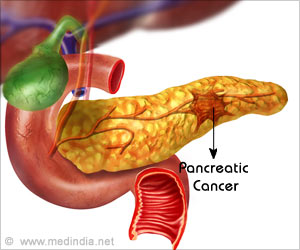The new pancreatic cancer genetic marker discovered by scientists may help predict outcomes with radiation therapy.

The team published the new work in the journal Clinical Cancer Research.
The IDO2 gene, which was first discovered by LIMR researchers in 2006, produces an enzyme that helps manage the immune system. During pregnancy, IDO2 and a related gene, IDO1, tone down the mother's immune system so it will not attack the fetus, for example. Cancer, however, hijacks the IDO genes' function. It uses IDO1 and 2 to conceal itself from the immune system. The researchers thought that shutting down the IDO enzymes could make the cancer visible to the immune system, thereby allowing the body's defenses the opportunity to fight the cancer. In fact, in previous research, the team found that mice lacking the IDO genes did not develop pancreatic cancer in a rodent model of the disease. The results suggested IDO genes are essential to pancreatic cancer progression.
Now, Drs. Brody and Prendergast find IDO2 spurs the formation of PDAC tumors. When the researchers induced the development of pancreatic cancer in mice, they found nearly 30 percent of rodents developed the invasive cancer. In mice that lack the IDO2 gene, however, the cancer grew in only 15 percent of the animals. Strikingly, all the mice lacking IDO2 that developed cancer were male. The results suggest IDO2's involvement in pancreatic cancer may affect females differently from males.
The researchers knew that many people in the general population have inherited, or germline, alterations in the IDO2 gene that turn off the gene's ability to mediate the immune system. So the scientists examined the IDO2 gene in a subgroup of pancreatic cancer patients from Thomas Jefferson University Hospital. Genetic testing is easy and cost effective, since researchers need only a sample of blood or cheek swab to detect this DNA.
"Besides IDO2's involvement in development of pancreatic cancer, we wanted to know whether IDO2 affects how patients respond to treatment," said Dr. Brody.
Advertisement
"The patients in our small cohort actually do better in specific treatment settings," said Dr. Brody. "They have improved disease-free survival when they receive radiotherapy."
Advertisement
Together, these initial findings suggest that IDO2 gene status has the potential to influence pancreatic care decision-making (i.e., precision therapy). In the future, physicians may be able to use the gene's status as a biomarker to inform their treatment recommendations.
"Developing new strategies to refine therapeutic options has been a top priority of our nationally recognized pancreatic cancer team at the Sidney Kimmel Cancer Center," says cancer researcher Karen Knudsen, PhD, Director of the Sidney Kimmel Cancer Center - Jefferson Health. "This breakthrough in understanding lays the foundation for determining what patients might most benefit from radiotherapy, and represents a major step forward toward the goal of precision oncology."
Although the researchers are excited about these findings, Dr. Brody suggests a lot of work needs to be done to validate the study in additional, larger cohorts, and ultimately, in a prospective clinical trial.
Source-Eurekalert















